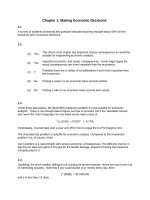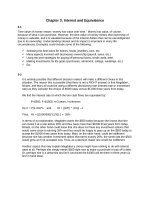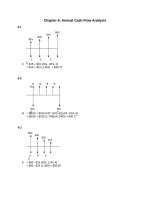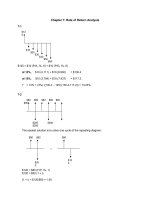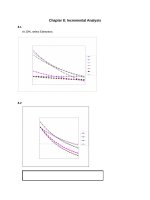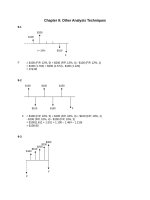Solution manual engineering economic analysis 9th edition ch09 other analysis techniques
Bạn đang xem bản rút gọn của tài liệu. Xem và tải ngay bản đầy đủ của tài liệu tại đây (109.07 KB, 33 trang )
Chapter 9: Other Analysis Techniques
9-1
$200
$100
i = 10%
$100
F
F
= $100 (F/P, 12%, 5) + $200 (F/P, 12%, 4) - $100 (F/P, 12%, 1)
= $100 (1.762) + $200 (1.574) - $100 (1.120)
= 379.00
9-2
$100
$100
$100
$100
F
$100
F
= $100 (F/P, 10%, 5) + $100 (F/P, 10%, 3) + $100 (F/P, 10%, 1)
- $100 (F/P, 10%, 4) - $100 (F/P, 10%, 2)
= $100(1.611 + 1.331 + 1.100 – 1.464 – 1.210)
= $136.80
9-3
$100
$300
$250
$200
$150
F
P
P = $100 (P/A, 12%, 5) + $50 (P/G, 12%, 5)
= $100 (3.605) + $50 (6.397)
= $680.35
F
= $680.35 (F/P, 12%, 5)
= $680.35 (1.762)
= $1,198.78
Alternate Solution
F
= [$100 + $50 (A/G, 12%, 5)] (F/A, 12%, 5)
= [$100 + $50 (1.775)] (6.353)
= 1,199.13
9-4
4x
3x
2x
x
i = 15%
F
F
= [4x – x(A/G, 15%, 4)] (F/A, 15%, 4)
= [4x – x(1.326)] (4.993)
= 13.35x
Alternate Solution
F
= 4x (F/P, 15%, 3) + 3x (F/P, 15%, 2) + 2x (F/P, 15%, 1) + x
= 4x (1.521) + 3x (1.323) + 2x (1.150) + x
= 13.35x
9-5
$5
$10
$15
$20
A = $30
$25
i = 12%
F
P
F
= $5 (P/G, 10%, 6) (F/P, 10%, 12) + $30 (F/A, 10%, 6)
= $5 (6.684) (3.138) + $30 (7.716)
= 383.42
9-6
Psystem 1
Psystem 2
PTotal
FTotal
= A (P/A, 12%, 10)
= $15,000 (5.650) = $84,750
= G (P/G, 12%, 10) = $1,200 (20.254) = $24,305
= $84,750 + $24,305 = $109,055
= PTotal (F/P, 12%, 10)= $109,055 (3.106) = $338,725
9-7
ia
= (1 + r/m)m – 1
= (1 + 0.10/48)48 – 1
= 0.17320
F
= P (1 + ia)5
= $50,000 (1 + 0.17320)5
9-8
G = $100
$100
21
P20
……..
55
P65
= $111,130
P20 = $100 (P/A, 12%, 35) + $100 (P/G, 12%, 35)
= $100 (8.176) + $100 (62.605)
= $7,078.10
P65 = P20 (F/P, 12%, 45) = $7,078.10 (163.988)
= $1,160,700
9-9
$30,000
A = $600
……………
n = 15
F
F
= $30,000 (F/P, 10%, 15) + $600 (F/A, 10%, 15)
= $30,000 (4.177) + $600 (31.772)
= $144,373
9-10
G = $60
$3,200
……...
n = 30
F
F
= $3,200 (F/A, 7%, 30) + $60 (P/G, 7%, 30) (F/P, 7%, 30)
= $3,200 (94.461) + $60 (120.972) (7.612)
= $357,526
9-11
F
= $100 (F/A, ½%, 24) (F/P, ½%, 60)
= $100 (25.432) (1.349)
= $3,430.78
9-12
$550
g = +$50
$100
i = 18%
P
F
P = $100 (P/A, 18%, 10) + $50 (P/G, 18%, 10)
= $100 (4.494) + $50 (14.352)
= 1,167.00
F
= $1,167 (F/P, 18%, 10)
= $1,167 (5.234)
= 6,108.08
9-13
F
= £100 (1 + 0.10)800
= £1.3 x 1035
9-14
$150
$100
i = ½%
F
F
= $150 (F/A, ½%, 4) (F/P, ½%, 14) + $100 (F/A, ½%, 14)
= $150 (4.030) (1.072) + $100 (14.464)
= 2,094.42
9-15
Using single payment compound amount factors
F
= $1,000 [(F/P, 4%, 12) + (F/P, 4%, 10) + (F/P, 4%, 8) + (F/P, 4%, 6)
+ (F/P, 4%, 4) + (F/P, 4%, 2)]
= $1,000 [1.601 + 1.480 + 1.369 + 1.265 + 1.170 + 1.082]
= $7,967
Alternate Solution
$1,000
$1,000
F
A A
A = $1,000 (A/P, 4%, 2) = $1,000 (0.5302)
= $530.20
F = $530.20 (F/A, 4%, 12)
= $530.20 (15.026) = $7,966.80
9-16
A = $20,000
Retirement
x
……….
……….
$48,500
A = $5,000
Adding to fund
21 - x
21 years
Age 55
x = years to continue working
age to retire = 55 + x
Age 76
Amount at Retirement
= PW of needed retirement funds
$48,500 (F/P, 12%, x) + $5,000 (F/A, 12%, x)
= $20,000 (P/A, 12%, 21- x)
Try x = 10
$48,500 (3.106) + $5,000 (17.549)
$20,000 (5.938)
= $238,386
= $118,760
so x can be < 10
Try x = 5
$48,500 (1.762) + $5,000 (6.353)= $117,222
$20,000 (6.974)
= $139,480
so x > 5
Try x = 6
$48,500 (1.974) + $5,000 (8.115) = $136.314
$20,000 (6.811)
= $136,220
Therefore, x = 6. The youngest age to retire is 55 + 6 = 61.
9-17
Geometric Gradient:
n = 10
g = 100%
A1 = $100
i = 10%
P = A1 [(1 – (1+g)n (1 + i)-n)/(i – g)]
= $100 [(1 – (1 + 1.0)10 (1 + 0.10)-10)/(0.10 – 1.0)]
= $100 [(1 – (1,024) (0.3855))/(-0.90)]
= $43,755
Future Worth
= $43,755 (F/P, 10%, 10)
= $43,755 (2.594)
= $113,500
9-18
i
n
= 0.0865/12
= 24
= 0.007208
F
= P (1 + i)n
= $2,500 (1 + 0.007208)24
= $2,970.30
9-19
F56 = $25,000 (F/P, 6%, 35) + $1,000 (F/A, 6%, 35)
+ $200 (P/G, 6%, 35) (F/P, 6%, 35) *
= $25,000 (8.147) + $1,000 (111.432) + $200 (165.743) (7.686)
= $569.890
* The factor we want is (F/A, 6%, 35) but it is not tabulated in the back of the book. Instead
we can substitute: (P/G, 6%, 35) (F/P, 6%, 35)
9-20
Assuming no disruption, the expected end-of-year deposits are:
A1
= $1,000,000 (A/F, 7%, 10)
= $1,000,000 (0.0724)
= $72,400
Compute the future worth of $72,400 per year at the end of 7 years:
F7
= $72,400 (F/A, 7%, 7)
= $626,550
Compute the future worth of $626,550 in 3 years i.e. at the end of year 10:
F10
= $626,550 (F/P, 7%, 3)
= $767,524
Remaining two deposits = ($1,000,000 - $767,524) (A/F, 7%, 2)
= $112,309
9-21
F
= $2,000 (F/A, 10%, 41)
= $2,000 (487.852)
= $975,704
Alternative solutions using interest table values:
F
= $2,000 (F/A, 10%, 40) + $2,000 (F/P, 10%, 40)
= $2,000 (45.259 + 442.593)
= $975,704
9-22
FW (Costs) = $150,000 (F/P, 10%, 10) + $1,500 (F/A, 10%, 10)
+ $500 (P/G, 10%, 7) (F/P, 10%, 7) – (0.05) ($150,000)
= $150,000 (2.594) + $1,500 (15.937) + $500 (12.763) (1.949)
- $7,500
= $417,940
9-23
Given:
n
i
P
= $325,000
A1-120 = $1,200
A84-120 = $2,000 - $1,200 = $800
F60
= $55,000 overhaul
= 12 (10)
= 120 months
= 7.2/12
= 0.60% per month
Find: F120 = ?
FP
FA1- 120
FA84-120
F60
= (F/P, 0.60%, 120) ($325,000)
= (1 + 0.0060)120 ($325,000)
= $666,250
= (F/A, 0.60%, 120) ($1,200)
= [((1 + 0.006)120 – 1)/0.006] ($1,200)
= $210,000
= (F/A, 0.60%, 36) ($800)
= [((1 + 0.006)36 – 1)/0.006] ($800)
= $32,040
= (F/P, 0.60%, 60) ($55,000)
= (1 + 0.006)60 ($55,000)
= $78,750
F120 = $666,250 + $210,000 + $32,040 + $78,750
= $987,040
9-24
Find F.
F = $150 (F/A, 9%, 10) + $150 (P/G, 9%, 10) (F/P, 9%, 10)
= $10,933
Alternate Solution
Remembering that G must equal zero at the end of period 1, adjust the time scale where
equation time zero = problem time – 1. Then:
F
= $150 (F/G, 9%, 11) = $150 (P/G, 9%, 11) (F/P, 9%, 11)
= $150 (28.248) (2.580)
= $10,932
9-25
isemiannual
= (1 + 0.192/12)6 – 1 = 0.10 = 10%
F1/1/12
= FA + FG
From the compound interest tables (i = 10%, n = 31):
FA = $5,000 (F/A, 10%, 31)
= $5,000 (181.944)
FG = -$150 (P/G, 10%, 31) (F/P, 10%, 31)
= -$150 (78.640) (19.194)
= -$226,412
F1/1/12
F7/1/14
= $909,720 - $226,412
= $683,308 (F/P, 10%, 5)
= $909,720
= $683,308
= $683,308 (1.611)
= $1,100,809
9-26
The monthly deposits to the savings account do not match the twice a month compounding
period. To use the standard formulas we must either
(1) compute an equivalent twice a month savings account deposit, or
(2) compute an equivalent monthly interest rate.
Method (1)
A
A
n=2
i = 0.045/24 = 0.001875
$75
Equivalent twice a month deposit (A)
= $75 (A/F, i%, n)
= $75 [0.001875/((1 + 0.001875)2 – 1)]
= $37.4649
Future Sum F1/1/15 = A (F/A, i%, 18 x 24)
= $37.4649 [((1 + 0.001875)432 – 1)/0.001875]
= $24,901
Method 2
Effective i per month (imonth) = (1 + 0.045/24)2 – 1
= 0.0037535
Future Sum F1/1/15 = A (F/A, imonth, 18 x 12)
= $75 [((1 + 0.0037535)216 – 1)/0.0037535]
= $24,901
9-27
Bob’s Plan
A = $1,500
……………..
i = 3.5%
n = 41
F7/1/2018
F
= $1,500 (F/A, 3.5%, 41)
= $1,500 (86.437)
= $129,650
Joe’s Plan
$40,000
i = 3.5%
n = 31
F7/1/2018
F
= $40,000 (F/P, 3.5%, 31)
= $40,000 (2.905)
= $116,200
Joe’s deposit will be insufficient. He should deposit:
$132,764 (P/F, 3.5%, 31) = $132,764 (0.3442) = $45,701
9-28
Fearless Bus
$200
$400
$600
$800
dividends
100 shares/yr
$65,000/yr salary
P = $65,000 (P/A, 9%, 5) + $200 (P/G, 9%, 5) + 500 shares of stock
= $65,000 (3.890) + $200 (7.111) + 500 shares of stock
= $254,272 + 500 shares of stock
F
= $257,272 (F/P, 9%, 5) + $500 shares ($60/share)
= $257,272 (1.539) + $30,000
= $421,325
Generous Electric
F
= $62,000 (F/A, 9%, 5) + 600 shares of stock
= $62,000 (5.985) + 600 shares of stock
= $371,070 + 600 shares of stock
Set FFearless = FGE
600 shares of GE stock + $371,070
= $421,325
Required Value of GE stock
= ($421,325 - $371,070)/600
= $50,255/600
= $83.76/share
9-29
A1
P = $50,000
Geometric gradient at a 10% uniform rate.
A1 = $10,000
i = 10%
g = 1-%
n = 8 yrs
Where i = g:
P = A1n (1 + i)-1
B/C
= PW of Benefits/PW of Cost
= [$10,000 (8) (1 + 0.10)-1]/$50,000
= 1.45
9-30
Cost
Uniform Annual
Benefit
B/COF A
B/COF B
B/COF C
A
$600
$158.3
B
$500
$138.7
C
$200
$58.3
= $158.3/[$600 (A/P, 10%, 5)]= 1.00
= $138.7/[$500 (A/P, 10%, 5)]= 1.05
= $58.3/[$200 (A/P, 10%, 5)] = 1.11
All alternatives have a B/C ratio > 1.00. Proceed with incremental analysis.
Cost
Uniform Annual
Benefit
B- C
$300
$8034
A- B
$100
$19.6
B/COF B-C = $80.4/[$300 (A/P, 10%, 5)] = 1.02
Desirable increment. Reject C.
B/COF A-B = $19.6/[$100 (A/P, 10%, 5)] = 0.74
Undesirable increment. Reject A.
Conclusion: Select B.
9-31
B/CA
B/CB
B/CC
= ($142 (P/A, 10%, 10))/$800= 1.09
= ($60 (P/A, 10%, 10))/$300 = 1.23
= ($33.5 (P/A, 10%, 10))/$150
= 1.37
Incremental Analysis
B- C Increment
B- C
∆ Cost $150
∆ UAB $26.5
∆B/∆C
= ($26.5 (P/A, 10%, 10))/$150
= 1.09
This is a desirable increment. Reject C.
A- B Increment
A- B
∆ Cost $500
∆ UAB $82
∆B/∆C
= ($82 (P/A, 10%, 10))/$500 = 1.01
This is a desirable increment. Reject B.
Conclusion: Select A.
9-32
Cost (including land)
Annual Income (A)
Salvage Value (F)
2 Stories
$500,000
$70,000
$200,000
5 Stories
$900,000
$105,000
$300,000
10 Stories
$2,200,000
$256,000
$400,000
B/C Ratio Analysis
Cost
- PW of Salvage Value = F(P/F,
8%, 20) = 0.2145F
PW of Cost
PW of Benefit = A (P/A, 8%, 20)
$500,000
$42,900
$900,000
$64,350
$2,200,000
$85,800
$457,100
$687,260
$835,650
$1,030,890
$2,114,200
$2,513,410
= 9.818A
B/C Ratio = PW of Benefit/PW of
Cost
Incremental B/C Ratio Analysis
Δ PW of Cost
ΔPW of Benefit
ΔB/ΔC = ΔPW of
Benefits/ΔPW of Costs
Decision
1.50
1.23
5 Stories Rather than 2
Stories
$835,650 - $457,100
= $378,550
$1,030,890 - $687,260
= $343,630
$343,630/$378,550
= 0.91
<1 Undesirable increment.
Reject 5 stories.
1.19
10 Stories Rather than 2
Stories
$2,114,200 - $457,100
= $1,657,100
$2,513,410 - $687,260
= $1,826,150
$1,826,150/$1,657,100
= 1.10
> 1 Desirable increment.
With ΔB/ΔC = 0.91, the increment of 5 stories rather than 2 stories is undesirable. The 10
stories rather than 2 stories is desirable.
Conclusion: Choose the 10-story alternative.
9-33
Note that the three alternatives have been rearranged below in order of increasing cost.
C
$120
$40
$0
1.45
First Cost
Uniform Annual Benefit
Salvage Value
Compute B/C Ratio
B
$340
$100
$0
1.28
A
$560
$140
$40
1.13
Incremental Analysis
Δ First Cost
Δ Uniform Annual
Benefit
Δ Salvage Value
Compute ΔB/ΔC
value
B- C
$220
$60
A- B
$220
$40
$0
1.19
$40
0.88
Benefit- Cost Ratio Computations:
Alternative A:
B/C
= [$140 (P/A, 10%, 6)]/[$560 - $40 (P/F, 10%, 6)]
= [$140 (4.355)]/($560 - $40 (0.5645)]
= 1.13
Alternative B:
B/C
= [$100 (P/A, 10%, 6)]/$340
= 1.28
Alternative C: B/C = [$40 (P/A, 10%, 6)]/$120
= 1.45
Incremental Analysis:
B- C
ΔB/ΔC = [$60 (P/A, 10%, 6)]/$220
= 1.19
B- C is a desirable increment.
A- B
ΔB/ΔC = [$40 (P/A, 10%, 6)/[$220 - $40 (P/F, 10%, 6)]
= 0.88
A- B is an undesirable increment.
Conclusion: Choose B.
The solution may be checked by Net Present Worth or Rate of Return
NPW Solution
NPWA
= $140 (P/A, 10%, 6) + $40 (P/F, 10%, 6) - $560
= $140 (4.355) + $40 (0.5645) - $560
= +$72.28
NPWB
= $100 (P/A, 10%, 6) - $340
= +$95.50
NPWC
= $40 (P/A, 10%, 6) - $120
= +$54.20
Select B.
Rate of Return Solution
Δ Cost
Δ Uniform Annual
Benefit
Δ Salvage Value
Computed Δ ROR
Decision
B- C
$220
$60
A- B
$220
$40
$0
16.2%
> 10%
Accept B. Reject C.
$40
6.6%
< 10%
Reject A.
Select B.
9-34
This is an above-average difficulty problem. An incremental Uniform Annual Benefit
becomes a cost rather than a benefit.
Compute B/C for each alternative
Form of computation used:
(PW of B)/(PW of C)
= (UAB (P/A, 8%, 8))/(Cost – S (P/F, 8%, 8))
= (UAB (5.747))/(Cost – S (0.5403))
= ($12.2 (5.747))/($100 - $75 (0.5403))
= 1.18
= ($12 (5.747))/($80 - $50 (0.5403)) = 1.30
= ($9.7 (5.747))/($60 - $50 (0.5403)) = 1.69
= ($12.2 (5.747))/$50
= 1.40
B/CA
B/CB
B/Cc
B/Cd
All alternatives have B/C > 1. Proceed with ∆ analysis.
Incremental Analysis
C- D Increment
C- D
$10
-$2.5
Δ Cost
Δ Uniform Annual
Benefit
Δ Salvage Value
$50
The apparent confusion may be cleared up by a detailed examination of the cash flows:
Year
0
1- 7
8
Cash Flow C
-$60
+$9.7
+$9.7
+$50
Cash Flow D
-$50
+$12.2
+$12.2
B/C ratio
Cash Flow C- D
-$10
-$2.5
+$47.5
= ($47.5 (P/F, 8%, 8)/($10 + $2.5 (P/A, 8%, 7))
= ($47.5 (0.5403)/($10 + $2.5 (5.206)
= 1.11
The C- D increment is desirable. Reject D.
B- C Increment
Δ Cost
Δ Uniform
Annual Benefit
Δ Salvage Value
B/C ratio
B- C
$20.0
$2.3
$0
= ($2.3 (0.5403)/$20
= 0.66
Reject B.
A- C Increment
A- C
Δ Cost
Δ Uniform Annual
Benefit
Δ Salvage Value
B/C ratio
$40.0
$2.5
$25.0
= ($2.5 (0.5403)/($40 - $25 (0.5403))
= 0.54
Reject A.
Conclusion: Select C.
9-35
Cost
UAB
PW of Benefits =
UAB (P/A, 15%, 5)
B/C Ratio
∆ Cost
∆ UAB
PW of Benefits
∆B/∆C
Decision
A
$100
$37
$124
B
$200
$69
$231.3
C
$300
$83
$278.2
D
$400
$126
$422.4
E
$500
$150
$502.8
1.24
1.16
0.93
1.06
1.01
B- A
$100
$32
$107.3
1.07
Reject A.
D- B
$200
$57
$191.1
0.96
Reject D.
E- B
$300
$81
$271.5
0.91
Reject E.
Conclusion: Select B.
9-36
By inspection one can see that A, with its smaller cost and identical benefits, is preferred to
F in all situations, hence F may be immediately rejected. Similarly, D, with greater benefits
and identical cost, is preferred over B. Hence B may be rejected. Based on the B/C ratio
for the remaining four alternatives, three exceed 1.0 and only C is less than 1.0. On this
basis C may be rejected. That leaves A, D, and E for incremental B/C analysis.
∆ Cost
∆ Benefits
PW of Benefits
∆B/∆C
Decision
Therefore, do A.
E- D
$25
$10
$10 (P/A, 15%, 5)
= $10 (3.352)
$10 (3.352)/$25 = 1.34
Reject D.
A- E
$50
$16
$16 (P/A, 15%, 5)
= $16 (3.352)
$16 (3.352)/$50 = 1.07
Reject E.
9-37
Investment= $67,000
Annual Benefit
= $26,000/yr for 2 years
Payback period
= $67,000/$26,000q= 2.6 years
Do not buy because total benefits (2) ($26,000) < Cost.
9-38
Payback Period
= Cost/Annual Benefit = $3,800/(4*$400)
= 2.4 years
A = $400
…………
n = 60 months
$3,800
Pattern of monthly
payments repeats for
2 more years
$3,800= $400 (P/A, i%, 4) + $400 (P/A, i%, 4) (P/F, i%, 12)
+ $400 (P/A, i%, 4) (P/F, i%, 24) + $400 (P/A, i%, 4) (P/F, i%, 36)
+ $400 (P/A, i%, 4) (P/F, i%, 48)
$3,800= $400 (P/A, i%, 4) [1 + (P/F, i%, 12) + (P/F, i%, 24) + (P/F, i%, 36)
+ (P/F, i%, 48)]
Try i = 3%
P(3%)
= $400 (3.717) [1 + 0.7014 + 0.4919 + 0.3450 + 0.2420]
= $1,486.80 [2.7803]
= $4,134
i too low
Try i = 4%
P(4%)
= $400 (3.630) [1 + 0.6246 + 0.3901 + 0.2437 + 0.1522]
= $1,452 [2.4106]
= $3,500
i too high
Try i = 3.5%
P(3.5%)
= $400 (3.673) [1 + 0.6618 + 0.4380 + 0.2898 + 0.1918]
= $1,469.20 [2.5814]
= $3,798
So i ≈ 3.5% per month
Nominal Rate of Return
= 12 (3.5%)
= 42%
9-39
Costs = Benefits at end of year 8
Therefore, payback period = 8 years.
9-40
Lease:
A = $5,000/yr
Purchase:
S = $500
$7,000
A = $3,500
(a) Payback Period
Cost
= $7,000
Benefit = $1,500/yr + $500 at any time
Payback
= ($7,000 - $500)/$1,500
= 4.3 years
(b) Benefit- Cost Ratio
B/C
= EUAB/EUAC
= [$1,500 + $500 (A/F, 10%, 6)]/[$7,000 (A/P, 10%, 6)]
= [$1,500 + $500 (0.1296)]/[$7,000 (0.2296)]
= 0.97
9-41
(a) Payback Periods
Period
-2
-1
0
1
2
3
Alternative A
Cash Flow
-$30
-$100
-$70
$40
$40
$40
Sum CF
-$30
-$130
-$200
-$160
-$120
-$80
Alternative B
Cash Flow
-$30
-$100
-$70
$32.5
$32.5
$32.5
Sum CF
-$30
-$130
-$200
-$167.5
-$135
-$102.5
4
5
6
7
$40
$40
$40
$40
-$40
$0
$40
$80
$32.5
$32.5
$32.5
$32.5
-$70
-$37.5
-$5
$27.5
PaybackA = 5.0 years
PaybackB = 7 years (based on end of year cash flows)
(b) Equivalent Investment Cost
= $30 (F/P, 10%, 2) + $100 (F/P, 10%, 1) + $70
= $30 (1.210) + $100 (1.100) + $70
= $216.3 million
(c) Equivalent Uniform Annual Worth = EUAB – EUAC
EUAWA
= $40 - $216.3 (A/P, 10%, 10)
= $4.81 million
EUAWB
= $32.5 - $216.3 (A/P, 10%, 20)
= $7.08 million
Since the EUAW for the Alternative B is higher, this alternative should be selected.
Alternative A may be considered if the investor is very short of cash and the short
payback period is of importance to him.
9-42
(a)
∆ Cost
∆UAB
Increment B- A
$300
$50
Incremental Payback = Cost/UAB
(b) ∆B/∆C = [$50 (P/A, 12%, 8)]/$300
= $300/$50
= 6 years
= 0.83
Reject B and select A.
9-43
(a)
Year
Conventional
Solar
0
1- 4
4
5- 8
8
9- 12
12
-$200
-$230/yr
-$1,400
-$60/yr
-$180
-$60/yr
-$180
-$60/yr
- $180
-$230/yr
-$230/yr
Payback = 8 yrs + $200/$170
|-----------------Part (a) ----------------------|
Solar –
Net Investment
Conventional
-$1,200
-$1,200
+$170/yr
-$520
-$180
-$700
+$170/yr
-$20
-$180
-$200
+$170/yr
+$480 Payback
-$180
+$300
= 9.18 yrs
(b)
The key to solving this part of the problem is selecting a suitable analysis method.
The Present Worth method requires common analysis period, which is virtually
impossible for this problem. The problem is easy to solve by Annual Cash Flow
Analysis.
EUACconventional- 20 yrs = $200 (A/P, 10%, 20) + $230
EUACsolar- n yrs
= $1,400 (A/P, 10%, n) + $60
For equal EUAC:
(A/P, 10%, n)
= [$253.50 - $60]/$1,400
= $253.50
= 0.1382
From the interest tables, n = 13.5 years.
9-44
(a) Net Future Worth
NFWA
NFWB
NFWC
NFWD
= $18.8 (F/A, 10%, 5) - $75 (F/P, 10%, 5)
= $13.9 (F/A, 10%, 5) - $50 (F/P, 10%, 5)
= $4.5 (F/A, 10%, 5) - $15 (F/P, 10%, 5)
= $23.8 (F/A, 10%, 5) - $90 (F/P, 10%, 5)
= -$6.06
= +$4.31
= +$3.31
= +$0.31
Select B.
(b) Incremental Analysis
Cost
UAB
Computed Uniform Annual Cost
(UAC)
B/C Ratio
Decision
B- C
$9.40
$9.23
1.02
Reject C.
∆ UAB
∆ UAC
∆B/∆C
Decision
(c) Payback Period
= $75/$18.8
= $50/$13.9
= $15/$4.5
= $90/$23.8
B
$50.0
$13.9
$13.19
A
$75.0
$18.8
$19.78
1.14
Ok
1.05
Ok
0.95
Reject
D- B
$9.90
$10.55
0.94
Reject D.
Conclusion: Select B.
Payback A
PaybackB
PaybackC
PaybackD
C
$15.0
$4.5
$3.96
= 4.0
= 3.6
= 3.3
= 3.8
D
$90.0
$23.8
$23
74
1.00
Ok
To minimize Payback, select C.
9-45
Cost
Annual Benefit
Useful Life
(a)
A
$50
$28.8
2 yr
B
$150
$39.6
6 yr
C
$110
$39.6
4 yr
Solve by Future Worth analysis. In future worth analysis there must be a common
future time for all calculations. In this case 12 years hence is a practical future time.
Alternative A
A = $28.8
$50
$50
$50
$50
$50
$50
FW
NFWA = $28.8 (F/A, 12%, 12) - $50 (A/P, 12%, 2) (P/A, 12%, 12)
= $28.8 (24.133) - $50 (0.5917) (24.133)
= -$18.94
Alternative B
A = $39.6
$150
$150
FW
NFWB = $39.6 (F/A, 12%, 12) - $150 (F/P, 12%, 6) - $150 (F/P, 12%, 12)
= $39.6 (24.133) - $150 [1.974 + 3.896]
= +$75.17
Alternative C
A = $39.6
$110
$110
$110
FW
NFWC = $39.6 (F/A, 12%, 12) - $110 (F/P, 12%, 4) - $110 (F/P, 12%, 8) –
$110 (F/P, 12%, 12)
= $39.6 (24.133) - $110 [1.574 + 2.476 + 3.896]
= +$81.61
Choose Alternative C because it maximizes Future Worth.
(b) Solve by Benefit-Cost ratio analysis
With neither input nor output fixed, incremental analysis is required.
Alternative C- Alternative A
Year
0
1
2
Alt. C
-$110
+$39.6
+$39.6
3
4
+$39.6
+$39.6
Alt. A
-$50
+$28.8
+$28.8
-$50
+$28.8
+$28.8
C- A
-$60
+$10.8
+$60.8
+$10.8
+$10.8
Four years is a suitable analysis period for Alternatives C and A.
For the increment C- A:
PW of Cost = $60
PW of Benefits
= $10.8 (P/A, 12%, 4) + $50 (P/F, 12%, 2)
= $10.8 (3.037) + $50 (0.7972)
= $72.66
ΔB/ΔC
= PW of Benefits/PW of Cost
= $72.66/$60 > 1
The increment of investment is acceptable and therefore Alternative C is preferred over
Alternative A.
Increment B- C
Year
0
1- 4
Alt. B
-$150
+$39.6
Alt. C
-$110
+$39.6
B- C
-$40
$0
4
5-6
6
7- 8
8
9- 12
$0
+$39.6
-$150
+$39.6
$0
+$39.6
-$110
+$39.6
$0
+$39.6
-$110
+$39.6
+$110
$0
-$150
$0
+$110
$0
Twelve years is a suitable analysis period for Alternatives B and C.
For the increment B- C
Ignoring the potential difficulties signaled by 3 sign changes in the B- C cash flow:
PW of Cost
= $40 + $150 (P/F, 12%, 6)
= $40 + $150 (0.5066)
= $115.99
PW of Benefits
ΔB/ΔC
= $110 (P/F, 12%, 4) + $110 (P/F, 12%, 8)
= $110 (0.6355) + $110 (0.4039)
= $114.33
= PW of Benefits/PW of Cost = $114.33/$115.99 < 1
The increment is undesirable and therefore Alternative C is preferred over Alternative B.
Alternative Analysis of the Increment B- C
An examination of the B- C cash flow suggests there is an external investment of money
at the end of Year 4. Using an external interest rate (say 12%) the +$110 at Year 4
becomes:
+$110 (F/P, 12%, 2) = $110 (1.254) = $137.94 at the end of Yr. 6.
The altered cash flow becomes:
Year
0
1- 6
6
7-8
8
B- C
-$40
$0
-$150 +$137.94 = -$12.06
$0
+$110
For the altered B- C cash flow:
PW of Cost
= $40 + $12.06 (P/F, 12%, 6)
= $40 + $12.06 (0.5066)
= $46.11
PW of Benefits
= $110 (P/F, 12%, 8)
= $110 (0.4039)
= $44.43
ΔB/ΔC = PW of Benefits/PW of Cost = $44.43/$46.11 < 1
The increment is undesirable and therefore Alternative C is preferred to Alternative B.
Solutions for part (b): Choose Alternative C.
(c)
Payback Period
Alternative A: Payback
Alternative B: Payback
Alternative C: Payback
= $50/$28.8 = 1.74 yr
= $150/$39.6 = 3.79 yr
= $150/$39.6 = 2.78 yr
To minimize the Payback Period, choose Alternative A.
(d)
Payback period is the time required to recover the investment. Here we have
three alternatives that have rates of return varying from 10% to 16.4%. Thus
each generates uniform annual benefits in excess of the cost, during the life of
the alternative. From this is must follow that the alternative with a 2-year life has
a payback period less than 2 years. The alternative with a 4-year life has a
payback period less than 4 years, and the alternative with a 6-year life has a
payback period less than 6 years.
Thus we see that the shorter-lived asset automatically has an advantage over
longer-lived alternatives in a situation like this. While Alternative A takes the
shortest amount of time to recover its investment, Alternative C is best for longterm economic efficiency.
9-46
(a) B/C of Alt. x
= [$25 (P/A, 10%, 4)]/$100
(b) Payback Period
x
= $100/$25
y
= $50/$16
z
= $50/$21
= 0.79
= 4 yrs
= 3.1 yrs
= 2.4 yrs
To minimize payback, select z.
(c) No computations are needed. The problem may be solved by inspection.
Alternative x has a 0% rate of return (Total benefits = cost).
Alternative z dominates Alternative y. (Both cost $50, but Alternative z yields more
benefits).
Alternative z has a positive rate of return (actually 24.5%) and is obviously the best of
the three mutually exclusive alternatives.
Choose Alternative z.
9-47
(a) Payback Period
Payback A
= 4 + $150/$350
= Year 4.4
